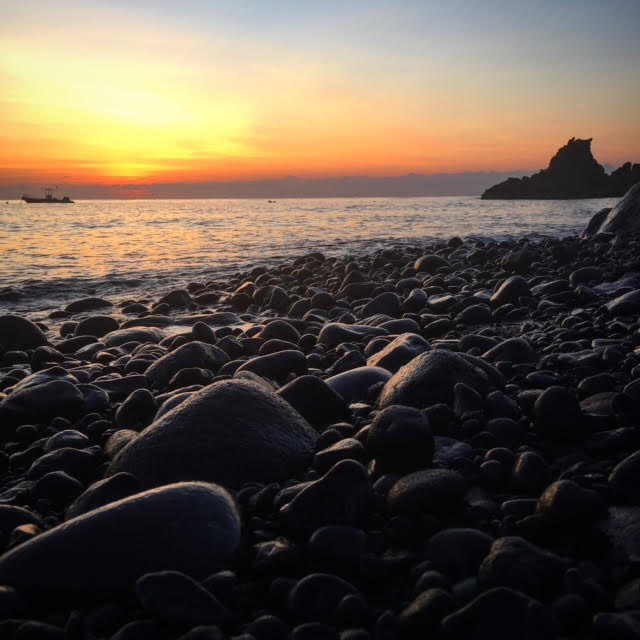We’ve all been there—finding ourselves with just a day to explore a new place and wanting to cram in as much as possible. Our latest escapade brought us to Bali, the “Island of the Gods,” with only about 24 hours on the clock. It was a last-minute decision, a spontaneous detour from our planned trip to Bangkok, but one that we couldn’t resist. Australians go like Americans to the Caribbean to party. There’s also the yogi crowd that file to the island. It was different for us. The allure of Indonesia was too strong, and with our friend Nick by our side, we embarked on what would become a whirlwind adventure.
A Risky Arrival
Our destination? Tulamben, a small village on the northeast coast of Bali, famous for the wreckage of the USS Liberty—a World War II ship resting just off the shore. But getting there wasn’t without its challenges. The island’s imposing Mount Agung, a volcano that could erupt at any moment, loomed over us. The threat was so real that our hotel was practically deserted. Most tourists had wisely evacuated, but not us. We were determined to catch a glimpse of this volatile giant, even if it meant risking a front-row seat to a volcanic eruption.
Bali Transport
Greeting us upon our arrival in Bali, besides the volcanic warning in the distance, was our driver. That is something we can’t recommend enough. Hire a driver for your time in Bali, especially if it is short. For a relatively small amount, we only paid $150 for two days worth of driving. When you think about this is to navigate around an entire island that is bigger than you think and you’ll spend hours on the road, it’s so worth it. Plus, this will maximize your time getting around.
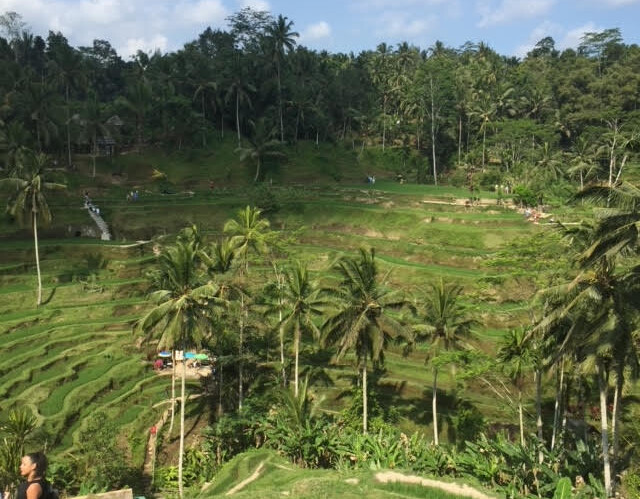
The Island of Temples
Bali is aptly named the “Island of the Gods” for its abundance of temples—over 20,000 scattered across the island. While visiting them all in one day was impossible, we made it to one of the most iconic: Tanah Lot. Perched on a cliff overlooking the Indian Ocean, Tanah Lot is not just a place of spiritual significance but also a marvel of architecture and natural beauty. Built in the 11th century, the temple is dedicated to the sea spirits and offers breathtaking views of the ocean from 70 meters above. The air is filled with the scent of incense, and the sound of waves crashing against the cliffs creates a serene atmosphere that’s hard to describe.
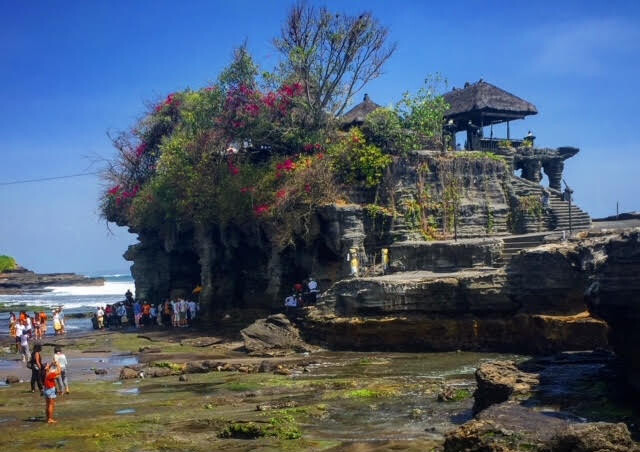
But Tanah Lot has more than just spirituality and scenery. It’s home to a large population of gray, long-tailed macaques. These mischievous monkeys are notorious for snatching anything they can get their hands on, so a word of advice: keep a tight grip on your belongings! And remember, respecting the local customs is a must. Visitors are required to wear sarongs and sashes, which are provided at the entrance if you’re not already dressed appropriately. You can also do what Sean did and get the proper local blessing
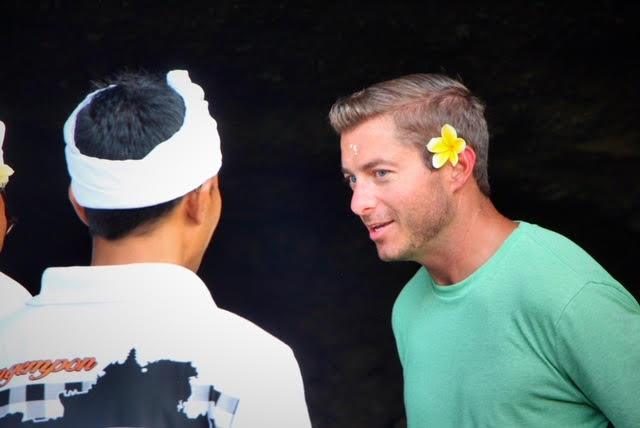
The Iconic Bali Rice Terraces
Next up, we headed to one of Bali’s most photographed landmarks—the Tegalalang Rice Terraces. Located in the village of Tegalalang, just a short drive north of Ubud, these terraces are a testament to Bali’s agricultural heritage. The terraces are not just a sight to behold but are part of a sophisticated irrigation system called Subak, recognized by UNESCO for its ingenuity. Carved into the hillsides, the terraces follow the natural contours of the landscape, creating a cascading effect that’s both functional and visually stunning.
Walking through the terraces, you can’t help but marvel at the vibrant green paddies and the intricate irrigation channels that have been maintained for centuries. The paths wind through the fields, offering endless opportunities for photos, each view more breathtaking than the last. We were there late in the day, which meant battling the heat and missing the magical morning mist that often blankets the terraces. But no complaints here—the beauty of this place shines through at any hour.

Diving Into History in Bali
With time running out, we rushed to the coast for the highlight of our trip: scuba diving at the USAT Liberty wreck. The wreck lies just a few yards off the shore of Tulamben and is one of the most accessible dive sites in Bali. Sean and Nick were eager to explore the underwater world, so they donned their gear and dove right in while I stayed above, manning the drone to capture some epic aerial shots.
The USAT Liberty, a United States Army cargo ship, was torpedoed by a Japanese submarine in 1942. The ship was beached on the shores of Tulamben but was later pushed into the sea by the eruption of Mount Agung in 1963. Today, it rests in shallow waters, making it perfect for divers of all levels. The wreck is teeming with marine life, from schools of barracuda to vibrant coral and sea fans. It’s a surreal experience, diving through history while surrounded by the bustling life of the ocean.
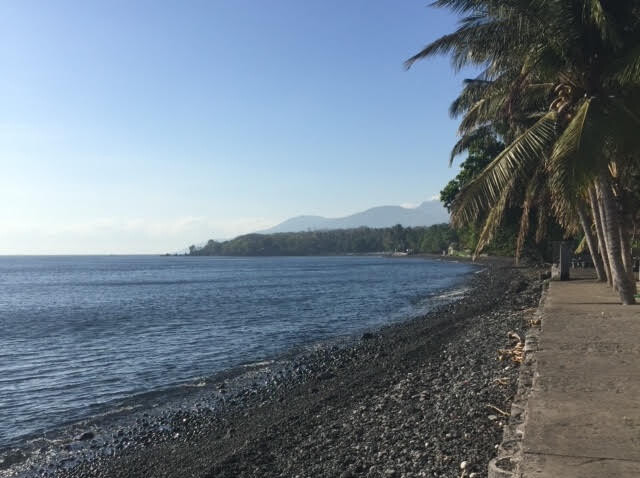
A Close Call with Mount Agung
All the while, Mount Agung loomed ominously in the background. The volcano, standing nearly 10,000 feet tall, is the highest point on the island and one of the most sacred. It’s also a ticking time bomb. The day we were there, the volcano was showing signs of activity, with seismic tremors and occasional ash plumes. The local authorities had issued the highest warning level, and tens of thousands of people had evacuated. But we were there, in the thick of it, hoping to witness something extraordinary without, you know, actually getting caught in an eruption.
Mount Agung has a central role in Balinese culture and spirituality. It’s a popular trekking destination, with climbers often starting their ascent at night to reach the summit by sunrise. The views from the top are said to be breathtaking, extending over the island and beyond to neighboring islands like Lombok. For us, just seeing the mountain from a safe distance was enough to enrich our experience in Bali.

Monkey Forest Sanctuary (Sacred Monkey Forest Sanctuary)
The Monkey Forest in Ubud is not just a popular tourist destination but also a spiritual and cultural landmark. It is home to three ancient Hindu temples that date back to the 14th century. The most important temple, Pura Dalem Agung, is dedicated to the god Shiva and is still used for religious ceremonies. The forest itself is considered sacred by the local community. The forest is a 27-acre nature reserve that features towering trees, ancient stone statues, and meandering pathways. The combination of the rich greenery, the presence of the monkeys, and the spiritual atmosphere creates a serene and mystical environment.
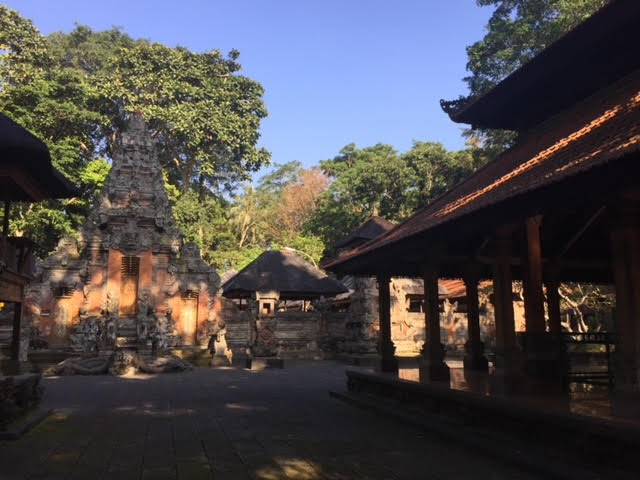
The sanctuary is home to over 700 long-tailed macaques. These monkeys are free to roam throughout the lush, dense forest, providing visitors with a unique opportunity to observe them in their natural habitat. The monkeys are known for their playful and sometimes mischievous behavior, making the visit an entertaining experience. If you come, be prepared for the monkeys to make yourself at home on you. You can see one below on Jeremy, but we all became brief resting spots.

Bat Cave Temple (Goa Lawah)
Goa Lawah is one of Bali’s key nine directional temples, which are believed to protect the island from evil spirits. The temple was established in the 11th century by the revered Hindu priest Mpu Kuturan. It’s an important pilgrimage site, especially during religious ceremonies where locals come to pay their respects.
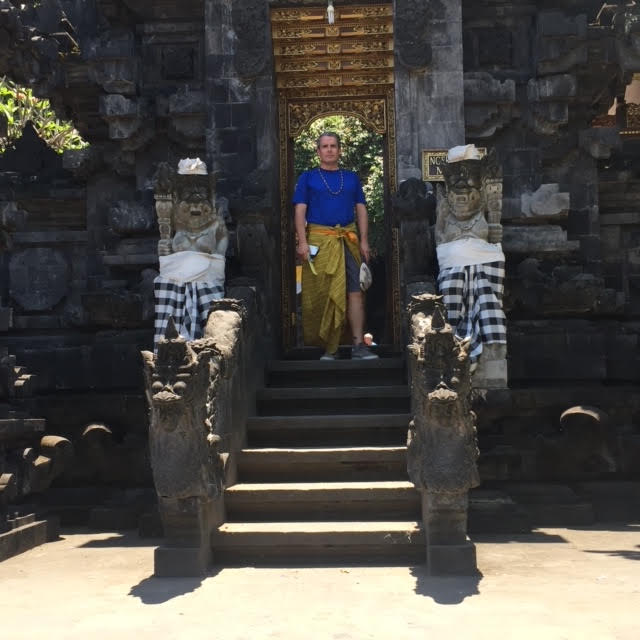
The temple is named after its main attraction—a cave that is home to thousands of bats. The sight of these bats, which often cover the walls of the cave, is both eerie and fascinating. According to legend, the cave extends all the way to the nearby Besakih Temple, the mother temple of Bali. This just adds to its mystical allure.
Goa Lawah is located near the coast, and the temple grounds offer beautiful views of the ocean. The combination of the cave, the swarming bats, and the coastal scenery makes it a visually striking location.

Eating in Bali
So, you’ll see a lot of spots to eat in Bali. Many will be right on the road as you stop at the more popular tourist destinations. And we hit some tasty spots. We told our driver on the second day that we wanted something local. We wanted true Balinese food. And wow, did he deliver. He took us off the main drag and took us to a spot he loved, Warung Lesehan Merta Sari. The place was absolutely packed for the lunch rush. However, it was obvious as soon as we walked in that we were the only tourists there. The menu is set, a family style meal you have to taste to understand. While sitting crossed-legged, we mowed down the satay and rest of the meal. This will always be one of our favorite meals we’ve ever had while traveling. Seriously, we still talk about it.

Time’s Up
And just like that, our 24 hours in Bali were up. We had seen and done so much in such a short time—temples, terraces, diving, monkeys, fantastic food, and a close encounter with a volcano. Bali had lived up to its reputation as a paradise. Even our brief visit was packed with more adventure than we had bargained for. It’s a reminder that even with limited time, you can still experience the magic of a place. So if you ever find yourself with just a day in Bali, don’t hesitate to dive in. You won’t regret it. And who knows, you might even find yourself planning your next, longer visit before you’ve even left the island.
